Electrical Characterization of a Double-Layered Conductive Pattern with Different Crack Configurations for Durable E-Textiles
Abstract
:1. Introduction
2. Materials and Methods
2.1. Theoretical Design of Conductive Patterns
2.2. Fabrication of Conductive Patterns
2.3. Measurement Setup
3. Results and Discussion
3.1. Observation before Tensile Deformation
3.2. Electrical Characterization under Single Tensile Deformation
3.3. Electrical Characterization under Cyclic Tensile Deformation
4. Conclusions
Author Contributions
Funding
Conflicts of Interest
References
- Cao, R.; Pu, X.; Du, X.; Yang, W.; Wang, J.; Guo, H.; Zhao, S.; Yuan, Z.; Zhang, C.; Li, C.; et al. Screen-Printed Washable Electronic Textiles as Self-Powered Touch/Gesture Tribo-Sensors for Intelligent Human−Machine Interaction. ACS Nano 2018, 12, 5190–5196. [Google Scholar] [CrossRef] [PubMed]
- Cherenack, K.; Zysset, C.; Kinkeldei, T.; Münzenrieder, N.; Tröster, G. Woven Electronic Fibers with Sensing and Display Functions for Smart Textiles. Adv. Mater. 2010, 22, 5178–5182. [Google Scholar] [CrossRef] [PubMed]
- Jinno, H.; Fukuda, K.; Xu, X.; Park, S.; Suzuki, Y.; Koizumi, M.; Yokota, T.; Osaka, I.; Takimiya, K.; Someya, T. Stretchable and Waterproof Elastomer-Coated Organic Photovoltaics for Washable Electronic Textile Applications. Nat. Energy 2017, 2, 780–785. [Google Scholar] [CrossRef]
- Karim, N.; Afroj, S.; Malandraki, A.; Butterworth, S.; Beach, C.; Rigout, M.; Novoselov, K.S.; Casson, A.J.; Yeates, S.G. All Inkjet-Printed Graphene-Based Conductive Patterns for Wearable E-textile Applications. J. Mater. Chem. C 2017, 5, 11640–11648. [Google Scholar] [CrossRef] [Green Version]
- Komazaki, Y.; Uemura, S. Stretchable, Printable, and Tunable PDMS-CaCl2 Microcomposite for Capacitive Humidity Sensors on Textiles. Sens. Actuators B Chem. 2019, 297, 126711. [Google Scholar] [CrossRef]
- Koshi, T.; Nomura, K.-I.; Yoshida, M. Requirements for Durability Improvement of Conductive Patterns Permeated in Textiles under Cyclic Tensile Deformation. Micromachines 2019, 10, 721. [Google Scholar] [CrossRef] [Green Version]
- Koshi, T.; Nomura, K.-I.; Yoshida, M. Electronic Component Mounting for Durable E-Textiles: Direct Soldering of Components onto Textile-Based Deeply Permeated Conductive Patterns. Micromachines 2020, 11, 209. [Google Scholar] [CrossRef] [Green Version]
- Li, Q.; Tao, X.M. Three-Dimensionally Deformable, Highly Stretchable, Permeable, Durable and Washable Fabric Circuit Boards. Proc. R. Soc. A 2014, 470, 20140472. [Google Scholar] [CrossRef]
- Takeshita, T.; Yoshida, M.; Takei, Y.; Ouchi, A.; Hinoki, A.; Uchida, H.; Kobayashi, T. Relationship between Contact Pressure and Motion Artifacts in ECG Measurement with Electrostatic Flocked Electrodes Fabricated on Textile. Sci. Rep. 2019, 9, 5897. [Google Scholar] [CrossRef] [PubMed]
- He, W.; Wang, C.; Wang, H.; Jian, M.; Lu, W.; Liang, X.; Zhang, X.; Yang, F.; Zhang, Y. Integrated Textile Sensor Patch for Real-Time and Multiplex Sweat Analysis. Sci. Adv. 2019, 5, eaax0649. [Google Scholar] [CrossRef] [PubMed] [Green Version]
- Fan, W.; He, Q.; Meng, K.; Tan, X.; Zhou, Z.; Zhang, G.; Yang, J.; Wang, Z.L. Machine-Knitted Washable Sensor Array Textile for Precise Epidermal Physiological Signal Monitoring. Sci. Adv. 2020, 6, eaay2840. [Google Scholar] [CrossRef] [PubMed] [Green Version]
- Takamatsu, S.; Lonjaret, T.; Crisp, D.; Badier, J.-M.; Malliaras, G.G.; Ismailova, E. Direct Patterning of Organic Conductors on Knitted Textiles for Long-Term Electrocardiography. Sci. Rep. 2015, 5, 15003. [Google Scholar] [CrossRef] [PubMed] [Green Version]
- Wicaksono, I.; Tucker, C.I.; Sun, T.; Guerrero, C.A.; Liu, C.; Woo, W.M.; Pence, E.J.; Dagdeviren, C. A Tailored, Electronic Textile Conformable Suit for Large-Scale Spatiotemporal Physiological Sensing in vivo. NPJ Flex. Electron. 2020, 4, 5. [Google Scholar] [CrossRef] [Green Version]
- Eom, J.; Heo, J.-S.; Kim, M.; Lee, J.H.; Park, S.K.; Kim, Y.-H. Highly Sensitive Textile-Based Strain Sensors using Poly (3,4-ethylenedioxythiophene):Polystyrene Sulfonate/Silver Nanowire-Coated Nylon Threads with Poly-L-Lysine Surface Modification. RSC Adv. 2017, 7, 53373–53378. [Google Scholar] [CrossRef] [Green Version]
- Liu, Y.; Li, X.; Lu, J.C. Electrically Conductive Poly (3,4-ethylenedioxythiophene)– Polystyrene Sulfonic Acid/Polyacrylonitrile Composite Fibers Prepared by Wet Spinning. J. Appl. Polym. Sci. 2013, 130, 370–374. [Google Scholar] [CrossRef]
- Zhang, J.; Seyedin, S.; Qin, S.; Lynch, P.A.; Wang, Z.; Wang, X.; Razal, J.M.; Yang, W. Fast and Scalable Wet-Spinning of Highly Conductive PEDOT: PSS Fibers Enables Versatile Applications. J. Mater. Chem. A 2019, 7, 6401–6410. [Google Scholar] [CrossRef]
- Araki, T.; Nogi, M.; Suganuma, K.; Kogure, M.; Kirihara, O. Printable and Stretchable Conductive Wirings Comprising Silver Flakes and Elastomers. IEEE Electron. Device Lett. 2011, 32, 1424–1426. [Google Scholar] [CrossRef]
- Hong, H.; Hu, J.; Yan, X. UV Curable Conductive Ink for the Fabrication of Textile-Based Conductive Circuits and Wearable UHF RFID Tags. ACS Appl. Mater. Interfaces 2019, 11, 27318–27326. [Google Scholar] [CrossRef]
- Jin, H.; Matsuhisa, N.; Lee, S.; Abbas, M.; Yokota, T.; Someya, T. Enhancing the Performance of Stretchable Conductors for E-Textiles by Controlled Ink Permeation. Adv. Mater. 2017, 29, 1605848. [Google Scholar] [CrossRef]
- Matsuhisa, N.; Kaltenbrunner, M.; Yokota, T.; Jinno, H.; Kuribara, K.; Sekitani, T.; Someya, T. Printable Elastic Conductors with a High Conductivity for Electronic Textile Applications. Nat. Commun. 2015, 6, 7461. [Google Scholar] [CrossRef]
- Koshi, T.; Iwase, E. Crack-Configuration Analysis of Metal Conductive Track Embedded in Stretchable Elastomer. Micromachines 2018, 9, 130. [Google Scholar] [CrossRef] [Green Version]
- Bossuyt, F.; Guenther, J.; Löher, T.; Seckel, M.; Sterken, T.; de Vries, J. Cyclic Endurance Reliability of Stretchable Electronic Substrates. Microelectr. Reliab. 2011, 51, 628–635. [Google Scholar] [CrossRef]
- Gray, D.S.; Tien, J.; Chen, S.C. High-Conductivity Elastomeric Electronics. Adv. Mater. 2004, 16, 393–397. [Google Scholar] [CrossRef]
- Huang, Z.; Hao, Y.; Li, Y.; Hu, H.; Wang, C.; Nomoto, A.; Pan, T.; Gu, Y.; Chen, Y.; Zhang, T.; et al. Three-Dimensional Integrated Stretchable Electronics. Nat. Electr. 2018, 1, 473–480. [Google Scholar] [CrossRef]
- Akogwua, O.; Kwabia, D.; Midturi, S.; Eleruja, M.; Babatope, B.; Soboyejoa, W.O. Large Strain Deformation and Cracking of Nano-Scale Gold Films on PDMS Substrate. Mater. Sci. Eng. B 2010, 170, 32–40. [Google Scholar] [CrossRef]
- Graudejus, O.; Jia, Z.; Li, T.; Wagner, S. Size-Dependent Rupture Strain of Elastically Stretchable Metal. Scr. Mater. 2012, 66, 919–922. [Google Scholar] [CrossRef] [Green Version]
- Graz, I.M.; Cotton, D.P.J.; Lacour, S.P. Extended Cyclic Uniaxial Loading of Stretchable Gold Thin-Films on Elastomeric Substrates. Appl. Phys. Lett. 2009, 94, 071902. [Google Scholar] [CrossRef]
- Koshi, T.; Nomura, K.-I.; Yoshida, M. Resistance Reduction of Conductive Patterns Printed on Textile by Curing Shrinkage of Passivation Layers. Micromachines 2020, 11, 539. [Google Scholar] [CrossRef]
- Zhang, S.; Sakane, M.; Nagasawa, T.; Kobayashi, K. Mechanical Properties of Copper Thin Films used in Electronic Devices. Procedia Eng. 2011, 10, 1497–1502. [Google Scholar] [CrossRef] [Green Version]
- Christ, J.F.; Aliheidari, N.; Pötschke, P.; Ameli, A. Bidirectional and Stretchable Piezoresistive Sensors Enabled by Multimaterial 3D Printing of Carbon Nanotube/Thermoplastic Polyurethane Nanocomposites. Polymers 2019, 11, 11. [Google Scholar] [CrossRef] [Green Version]
- Tian, B.; Yao, W.; Zeng, P.; Li, X.; Wang, H.; Liu, L.; Feng, Y.; Luoa, C.; Wu, W. All-Printed, Low-Cost, Tunable Sensing Range Strain Sensors based on Ag Nanodendrite Conductive Inks for Wearable Electronics. J. Mater. Chem. C 2019, 7, 809–818. [Google Scholar] [CrossRef]
- Hu, J. Structure and Mechanics of Woven Fabrics, 1st ed.; Woodhead Publishing: Cambridge, UK, 2004; pp. 91–122. [Google Scholar]
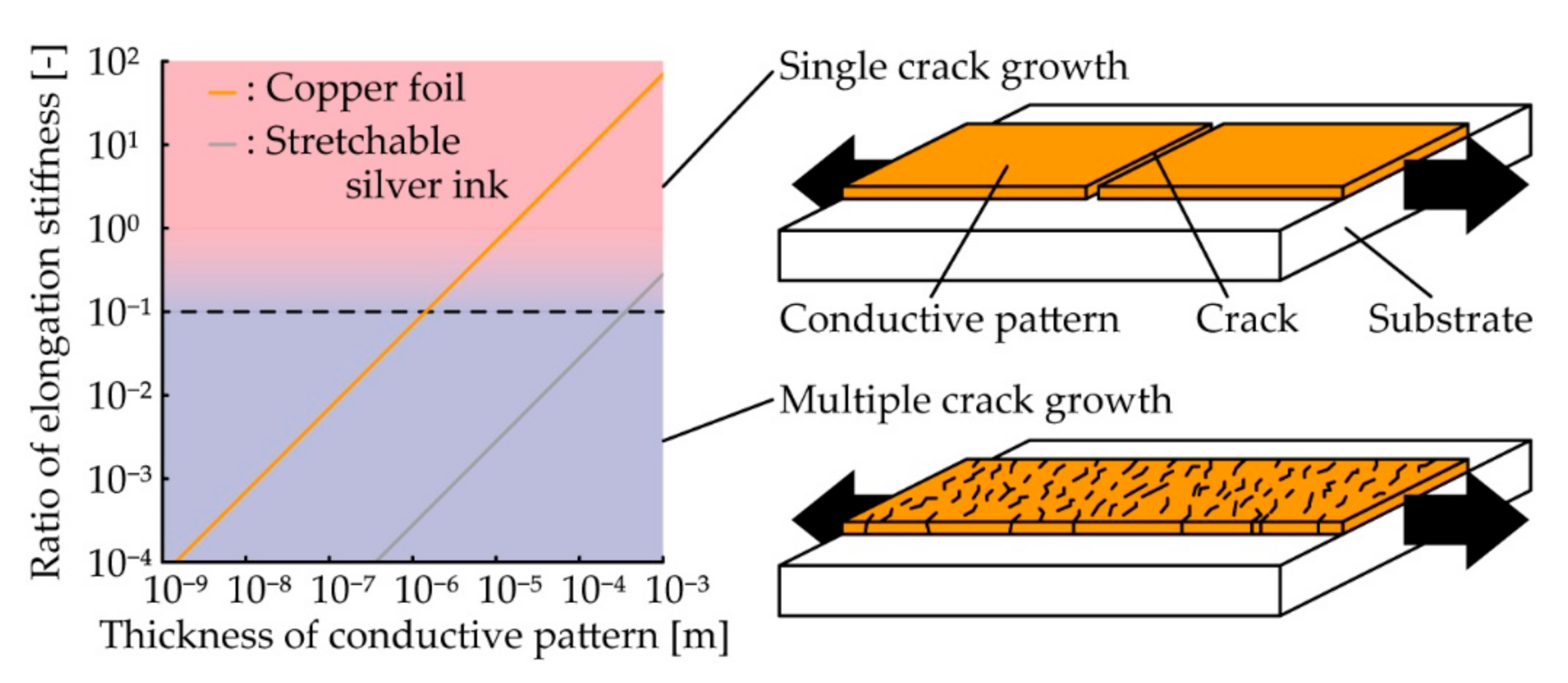
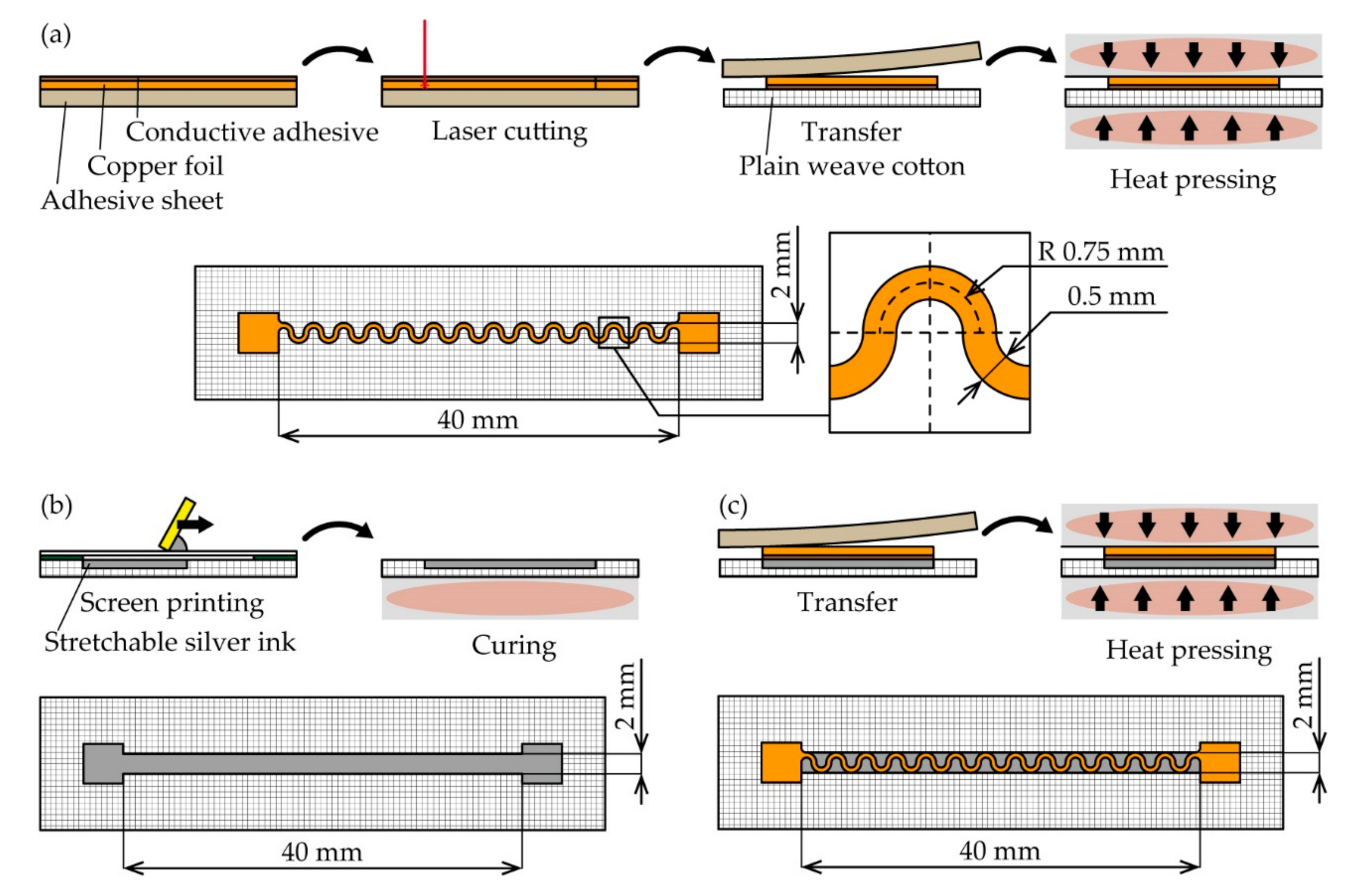

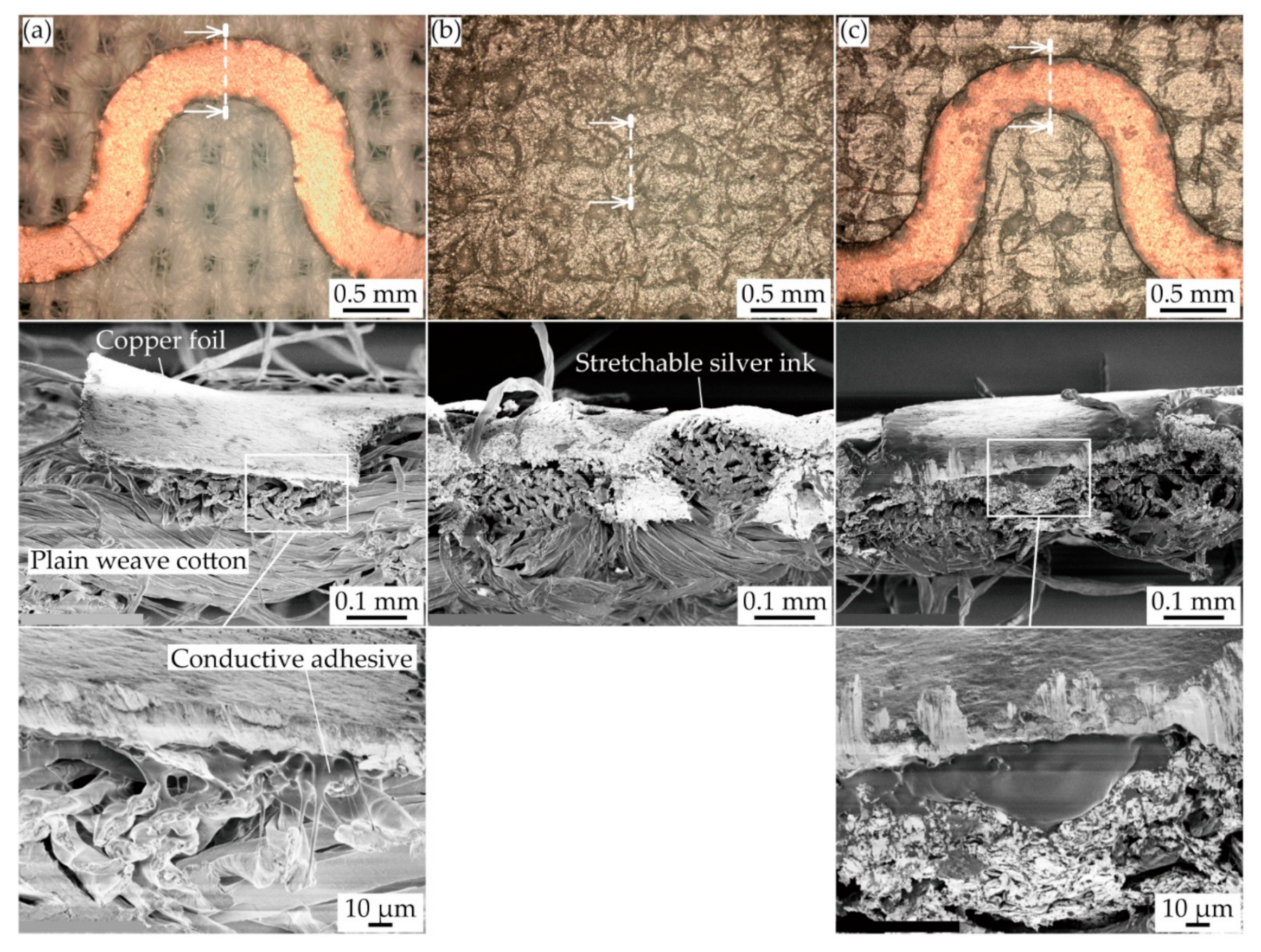

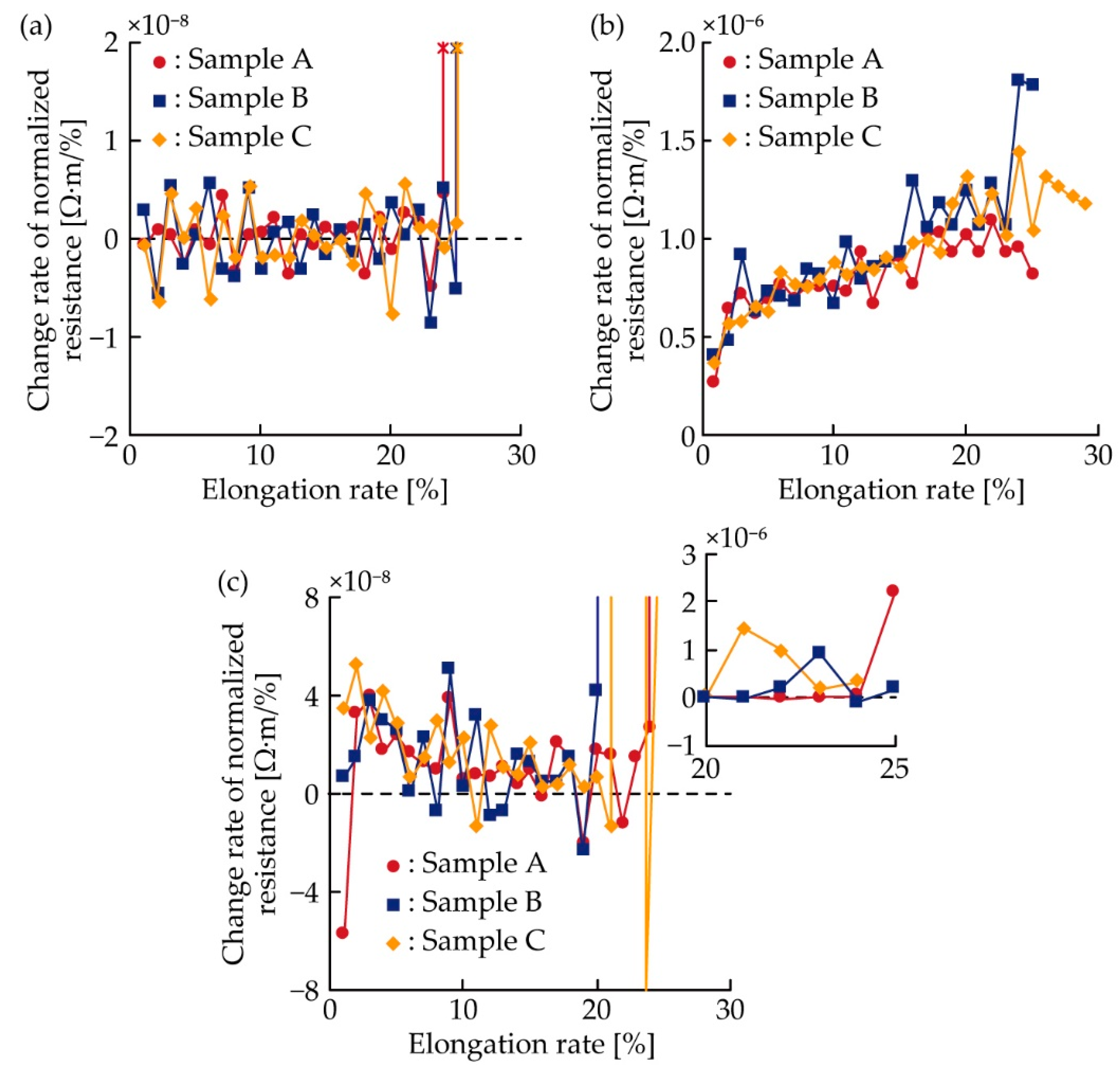

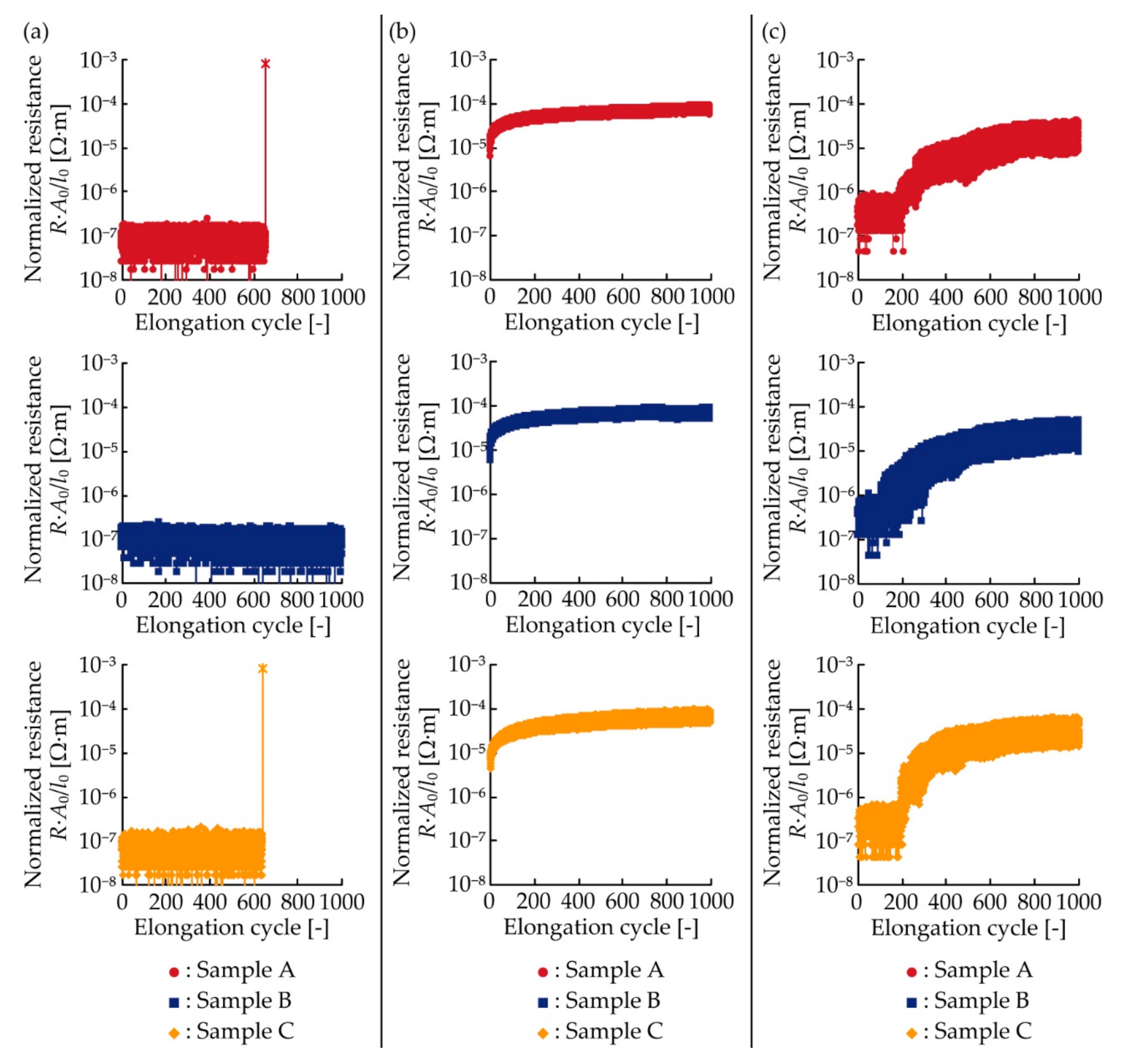
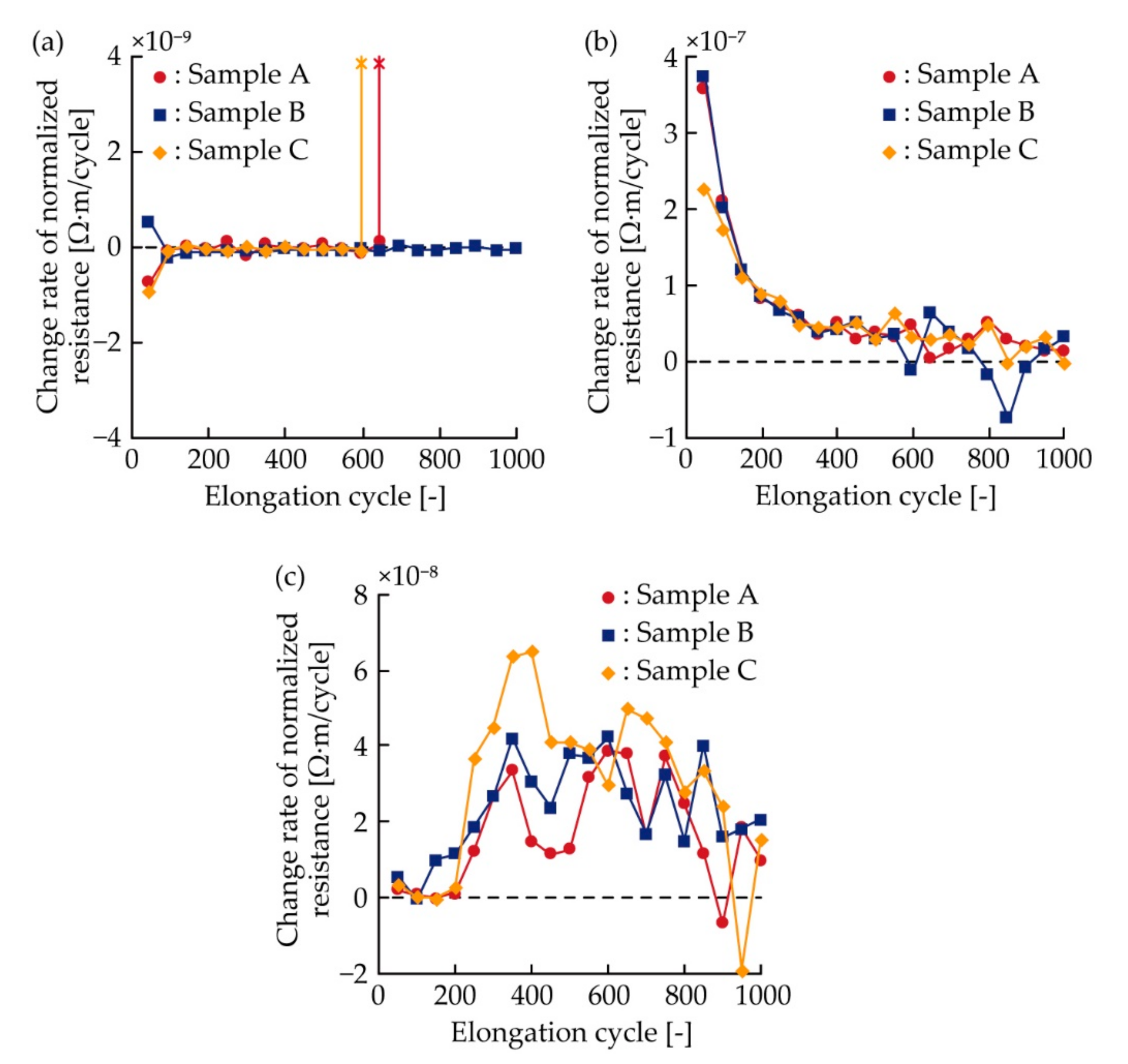

Publisher’s Note: MDPI stays neutral with regard to jurisdictional claims in published maps and institutional affiliations. |
© 2020 by the authors. Licensee MDPI, Basel, Switzerland. This article is an open access article distributed under the terms and conditions of the Creative Commons Attribution (CC BY) license (http://creativecommons.org/licenses/by/4.0/).
Share and Cite
Koshi, T.; Nomura, K.-i.; Yoshida, M. Electrical Characterization of a Double-Layered Conductive Pattern with Different Crack Configurations for Durable E-Textiles. Micromachines 2020, 11, 977. https://doi.org/10.3390/mi11110977
Koshi T, Nomura K-i, Yoshida M. Electrical Characterization of a Double-Layered Conductive Pattern with Different Crack Configurations for Durable E-Textiles. Micromachines. 2020; 11(11):977. https://doi.org/10.3390/mi11110977
Chicago/Turabian StyleKoshi, Tomoya, Ken-ichi Nomura, and Manabu Yoshida. 2020. "Electrical Characterization of a Double-Layered Conductive Pattern with Different Crack Configurations for Durable E-Textiles" Micromachines 11, no. 11: 977. https://doi.org/10.3390/mi11110977
APA StyleKoshi, T., Nomura, K.-i., & Yoshida, M. (2020). Electrical Characterization of a Double-Layered Conductive Pattern with Different Crack Configurations for Durable E-Textiles. Micromachines, 11(11), 977. https://doi.org/10.3390/mi11110977




